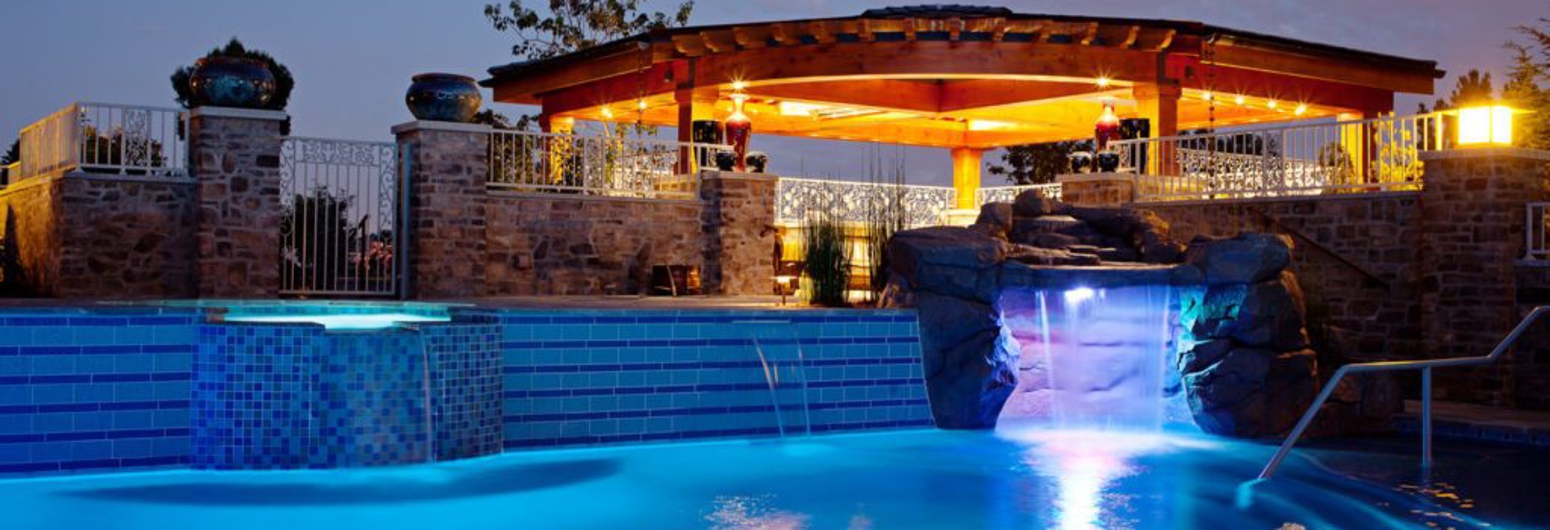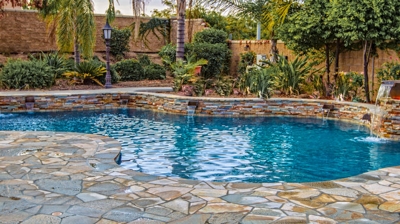There are more innovative pool options than ever, from elaborate pool shapes and features to different types of water treatment methods that keep pool-goers safe and comfortable. Saltwater pools are an increasingly popular option with numerous advantages, but they require a different type of care and maintenance than traditional pools.
All in all, saltwater pool maintenance is easier and more affordable than chemically chlorinated pools – but you still need to be aware of those differences so you know how to maintain a saltwater pool easily and effectively. To many, the greater ease of maintenance is more of a bonus when compared to the main reason saltwater pools are becoming popular: health improvements.
Many turn to saltwater pools initially because they feel better and notice fewer negative effects, most notably on their skin, and they are further pleased to find out that saltwater pools are also easier to maintain. With the following tips, you’ll be able to enjoy your saltwater pool far into the future with minimal labor.
How To Maintain a Saltwater Pool
The most common maintenance need for saltwater pools is to periodically check the salt levels to determine whether to add more salt to the pool (or dilute it) to maintain the proper salt levels (salinity). This requires a little knowledge of saltwater chemistry – luckily, the chemistry involved in learning how to maintain a saltwater pool is less than required for chemical chlorine pools.
To most accurately determine the correct salinity level for your saltwater pool, consult the documentation that came with your salt electrolysis machine, which should give you the most accurate salt levels according to your pool’s volume.
Generally, a salt level of 3,200 ppm (parts per million) is ideal, and 3,100 to 3,400 is good. Some systems even allow for levels as low as 2,700 and/or as high as the 4,000s – but defer to the range given in your equipment’s documentation to ensure that it operates only as intended.
It’s important to be certain of the proper salt level both to keep the pool hygienic and because incorrect salt levels can damage your equipment. Some saltwater electrolysis machines even have an automatic shutoff to protect the equipment if the salinity level exceeds the proper range. Always be sure to check your device from to time to time to make sure it’s running properly.
There are several ways to test the salinity of your pool:
- Salt-reading features on some saltwater electrolysis machines
- Pool test strips that test for salt
- A digital salinity meter
Each method has its advantages and disadvantages, and the most accurate reading will only be achieved by double- or triple-checking salinity readings with different methods, instead of relying on just one.
Once you’ve obtained an accurate salinity reading, you’ll be able to determine how much salt to add to raise the salinity (or the amount of water to add if must be lowered). Your electrolysis manual should have a handy chart to consult, which compares the volume of water with the salinity level and tells you the amount of salt (usually measured in pounds) to add.
Typically, a well-maintained saltwater pool will not require more than a few bags of salt per year, because salt does not evaporate like chlorine chemicals, and the natural chlorine molecules produced by electrolysis are continually recombined back into salt.
Related: A Guide to Summertime Outdoor Pool Maintenance
Preventative Maintenance for Saltwater Pools
While you’re at it, you can also check various other chemical measurements (note the proper range in parentheses), such as:
- Total Dissolved Solids (below 6,000 ppm)
- Water Hardness (200–400 ppm)
- pH Level (7.2–7.8)
- Stabilizer (60–80 ppm)
- Total Alkalinity (80–120 ppm)
- Phosphates (below 100 ppb)
- Nitrates (below 5 ppb)
- Free Chlorine (1–3 ppm)
Keeping these measurements at the right level reduces the demand put on your sanitation process to begin with. This lowers the amount of salt needed and the wear placed on your saltwater electrolysis machine, ensuring longer operating efficiency.
Along the same lines, you can further maximize preventative maintenance with the use of a self-cleaning pool system – and for outdoor pools, diligent use of a pool cover is extremely helpful (especially during inclement weather).
Keep Your Saltwater Pool Circulating
It’s also important to keep your saltwater pool circulating, which ensures impurities don’t accumulate and are instead continually sent through your pool filter and electrolysis machine.
Your pool pump accomplishes this vital task, and it should be set to run long enough to circulate the total volume of water 1–2 times per day, for which you’ll need accurate flow metering. (Pro tip: many local governing entities offer rebates on energy-efficient pool pumps.)
You’ll want to regularly clean your skimmer filter basket of debris as well as the pool filter. Normally, the filter needs cleaning when its pressure gauge reaches 8–10 PSI higher than its baseline level.
You should also learn how to adjust your pool pump’s settings according to changing factors, such as water temperature, seasonal changes, and frequency of pool use.
Maintaining the Pool Itself
For concrete pools, the concrete surfaces may need to be treated or repaired (such as by sealing or staining) after a long enough time, because salt gradually corrodes concrete.
This is not true of glazed tiles, though, which makes tile work a great way to reduce corrosion to concrete saltwater pools. Alternatively, there are special sealants that protect a concrete pool’s surface not only from salt but from UV rays and abrasions caused by toys or other hard objects. Fiberglass pools, on the other hand, are much less prone to saltwater corrosion, minimizing these kinds of maintenance needs almost entirely.
What Exactly Makes Saltwater Pools Different (it May Surprise You!)
Though there are major differences between traditional chlorine pools and saltwater pools, whether or not there is chlorine in the pool is not one of those differences – rather, they differ in how the pool’s chlorine content is produced.
The salt in saltwater pools consists of the same sodium chloride (NaCl) everyone knows of as table salt. As the saltwater passes by the saltwater pool’s electrified metal plate (aka a salt chlorine generator), the sodium and chloride ions are split from each other, resulting in free chlorine. Hence, a saltwater pool is still disinfected through the presence of chlorine.
So the key difference between saltwater and traditional chlorine pools is in how the chlorine originates – and the differences must be felt to be believed. More than ever, saltwater pools are proliferating, giving swimmers the choice between pools disinfected by industrially manufactured chlorine chemicals or instead by chlorine produced out of what starts out as generally harmless (or even helpful, to some extent) table salt instead.
The Advantages of Saltwater Pools
Many find that saltwater pools are much gentler on the skin and have less of a chemical smell. Also, when you investigate how to maintain a saltwater pool, you’ll find that their cost savings amount to several hundred dollars saved on pool chemicals per year.
The cost of salt is much cheaper – but be aware that you’ll still need to budget for the possibility of needing to replace the saltwater electrolysis system every five to seven years. If you follow the tips outlined above, you will radically lengthen the lifespan of your salt chlorine generator/electrolysis system.
Thanks to the fact that saltwater pools have increased in popularity, the cost of a new saltwater pool is becoming closer to the cost of a new chlorine pool. You can safely assume that, when starting from scratch, a saltwater pool will be significantly more affordable in addition to being gentler on the pool goers skin, eyes, and body overall.
It’s even possible to convert an old chlorine pool into a saltwater pool. The costs of doing so ranges from about $600 to $2,200 (depending on factors such as pool dimensions) – far less than the cost of a brand new pool.
Ease of cleaning is another advantage of saltwater pools. Traditional chlorine pools must be fully drained and scrubbed periodically, while saltwater pools do not require this.
Note that saltwater pools do still have some cleaning requirements, such as removing salt-stain lines from dark tiles – the cleaning needs are simply much less. Salt is even preferred in fiberglass pools, due to the fact that chlorine pool chemicals are harsher on the fiberglass shell’s gel-coat finish.
Related: How Much Does It Cost to Maintain a Pool?
Saltwater Pools Are Easy and More Affordable To Maintain
If you’ve been wondering how to maintain a saltwater pool, you’ll no doubt be even more eager to invest in one yourself when you see how easy and affordable it is. We’re here to help make owning a custom pool of any kind an easy and fun investment that puts a smile on your family’s face year after year.
With over 75 years of experience building and remodeling an incredibly diverse variety of pools and water features, California Pools is capable of everything that goes into pool creation, renovation, and all related skills, including:
- Pool decks
- Landscaping
- Pool covers & safety fencing
- Outdoor recreational areas & equipment
- Lighting and fire features
- System automation
- Much more!
We rely on only the best industry-leading practices while working directly with the homeowner throughout the process in order to bring their vision to life and provide the backyard pool setting of their dreams. To learn more about how to maintain saltwater pools or get a quote, find your nearest California Pools location – and turn your backyard into an oasis.



